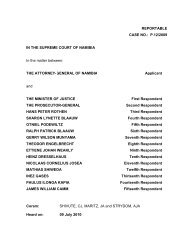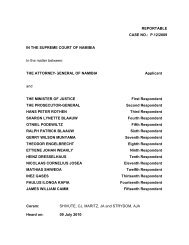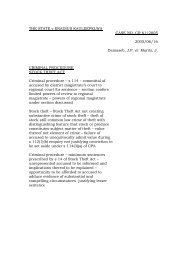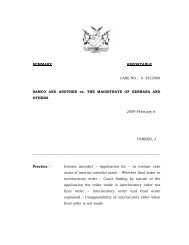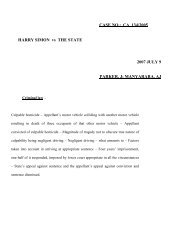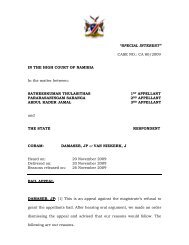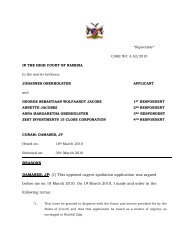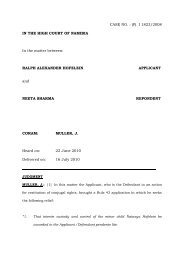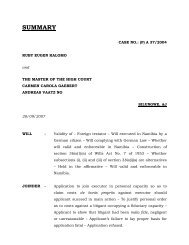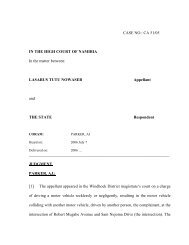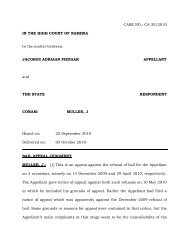JOSEPH GERSON GARISEB versus THE STATE - Superior Courts ...
JOSEPH GERSON GARISEB versus THE STATE - Superior Courts ...
JOSEPH GERSON GARISEB versus THE STATE - Superior Courts ...
Create successful ePaper yourself
Turn your PDF publications into a flip-book with our unique Google optimized e-Paper software.
REPUBLIC OF NAMIBIAIN <strong>THE</strong> HIGH COURT OF NAMIBIACASE NO. CC5/2003In the matter between:<strong>JOSEPH</strong> <strong>GERSON</strong> <strong>GARISEB</strong>Applicantand<strong>THE</strong> <strong>STATE</strong>RespondentCORAM:VAN NIEKERK, JHeard: 15 June 2009Delivered: 22 June 2009________________________________________________________________________JUDGMENT: APPLICATION FOR LEAVE TO APPEALVAN NIEKERK, J: [1] This is an application for leave to appealagainst sentence. I convicted the applicant and his co-accused on 16October 2006 after a trial on a count of murder, three counts ofhousebreaking with intent to rob and robbery with aggravatingcircumstances and one count of robbery with aggravating circumstances.On the count of murder I sentenced applicant to a prison sentence of 40years. On count 2 the Court sentenced him to 16 years imprisonment
2and ordered that 11 years run together with the sentence on count 1. Allthe other sentences of 14, 8 and 3 years respectively were ordered to runconcurrently with the sentence imposed on count 1. The effect is thatthe applicant must serve 45 years in total.[2] Applicant obtained the assistance from another inmate to draw hisapplication for leave to appeal. Some of the seventeen or so grounds ofappeal are impossible to understand.When I asked applicant, whoappeared in person, whether he could explain their meaning or intention,he was also at a loss to shed any light on them. I shall therefore confinemyself to those grounds of appeal that are comprehensible. Applicantfurther stated during oral argument that his complaint is against the 40year sentence on count 1 and not against the other sentences imposed.The result is that the grounds of appeal may be conveniently combinedand summarized to the following:1. The Court erred in not finding that the applicant committed theoffence of murder with the absence of dolus directus.2. The Court erred in its assessment that there were aggravatingcircumstances present. More particularly, the Court erred in itsfindings that applicant wielded a dangerous weapon before,during or after the commission of the crimes, and/or inflicted
3grievous bodily harm and/or threatened to inflict grievousbodily harm.3. The Court erred in under-emphasising the mitigating factorsand over-emphasising the aggravating factors, particularly theseriousness of the offence.4. The Court erred in under-emphasising the reformative purposeof punishment.5. The sentence of 40 years on the murder count is shockinglyinappropriate.[3] The first ground of appeal is clearly erroneous. The finding of theCourt was indeed that the murder was committed with absence of dolusdirectus.[4] The second ground of appeal is strictly speaking only relevant inrelation to counts 2-5 where the indictment alleged (and the Court found)that aggravating circumstances as meant in section 1 of the CriminalProcedure Act, 51 of 1977, were present. I deal with this aspect becauseit receives a great deal of attention in the application for leave to appeal.Furthermore during oral argument is appeared that applicant feltaggrieved because he allegedly did not inflict the fatal blows with any ofthe instruments used to assault the deceased.
4[5] Applicant overlooks an important aspect of the Court’s finding onthe merits of this matter. This is that he and the co-accused committedthe murder and the other offences with common purpose. It thereforedoes not matter who dealt the fatal blows. I did find in their favour thatthe State did not prove that they planned to murder the deceased.However, they did plan to attack and overpower the deceased and theyboth participated to about equal degree in carrying out this plan. Theyeach assaulted the deceased in various ways in the presence and to theknowledge of the other in the execution of their common purpose, whichwas to obtain the keys to the safes and shop and to lay their hands onmoney and other valuables. In the process they repeatedly assaultedand tortured the deceased in a cruel manner and tied him up so that hecould not defend himself or escape. Even if the home made braai forkused during the assaults was not intended to be used as a weapon whenit was made by applicant’s co-accused, it was used very effectively tocause pain and injury on several places on the deceased’s body. The coaccusedcarried a large knife to the knowledge of applicant when they leftKransneus that day.This knife was also used in the attack upondeceased. Other items like a knobkierie, a wooden dropper and a vehicleexhaust pipe were also found close by the deceased’s body of which atleast the latter was indeed used to hit the deceased on the head. Themain cause of death was the head injuries. There is also evidence thatapplicant kicked the deceased with a shod foot in the ribs. What is clear
5is that all the items involved were used as weapons and clearly were usedin a dangerous manner.In my view there is no merit in this ground ofappeal.[6] Regarding the third ground of appeal applicant submitted that themitigatory factors were ignored or under-emphasised.The mitigatoryfactors were certainly not ignored as the judgment on sentence clearlyshows. However, the problem for applicant is that the mitigatory factorsare so few.The Court had regard to his personal circumstances,upbringing and education, but found that the aggravating factors faroutweigh the few mitigating factors. I specifically dealt with the reasonswhy I considered his youthfulness not to be a factor which should inclineme towards a much lighter sentence. It is permissible to accord differentweights to the different relevant factors when considering what sentenceto impose, (S v De Kock 1997 (2) SACR 171 (T) 197g-h), even to the extentthat mitigating factors have no actual effect on the sentence, especially ifthe crime is really serious. For example, in S v Skenjana 1985 (3) SA 51(A) 54A, the Appellate division agreed with the Court a quo that thepersonal circumstances of the appellant did not have a great deal ofweight when viewed against the enormity of the crime committed. In thiscase the same approach was taken. The Namibian Supreme Court in thecase of S v Paulus Alexander (Case No SA 5/1995 unreported judgmentdelivered 13/2/03) followed the same approach having referred with
6approval to the case of S v Matolo 1998 (1) SACR 206 (O) at 211D-F,where the following was said (the quote is from the English headnote at208G-I):“Held, that in cases like the present the interests of society is a factorwhich plays a material role and which requires serious consideration.Our country at present suffers an unprecedented, uncontrolled andunacceptable wave of violence, murder, homicide, robbery and rape. Ablatant and flagrant want of respect for the life and property of fellowhuman beings has become prevalent. The vocabulary of our courts todescribe the barbaric and repulsive conduct of such unscrupulouscriminals is being exhausted. The community craves the assistance ofthe courts: its members threaten, inter alia, to take the law into theirown hands. The courts impose severe sentences, but the momentum ofviolence continues unabated. A court must be thoroughly aware of itsresponsibility to the community, and by acting steadfastly, impartiallyand fearlessly, announce to the world in unambiguous terms its utterrepugnance and contempt of such conduct.”[7] I do not think that there is any reasonable prospect that theSupreme Court will disagree with the approach I followed or the mannerin which I applied it to the facts of this case.[8] As far as the fourth ground of appeal is concerned, there is nomerit in it. Although I agree with applicant’s submission that the longperiod of effective imprisonment imposed in this case would not tend tohis rehabilitation, the aim of the punishment was to remove the
7applicant from society for a very long time because of the danger heposes to it. That this is a permissible approach in appropriate cases isclear (see e.g. S v Nkambule 1993 (1) SACR 136 (A) 147f; S v Mhlakaza1997 (1) SACR 515 (SCA) 519h-i). The applicant’s record of previousconvictions does not fill me with much hope that he will reform.Hecommitted the offences in this case while on the run from the police afterhaving committed a serious offence of housebreaking with intent to stealand theft for which he served two years imprisonment and indicates asevere lack of respect for society and the law.The violent and cruelnature of the assaults upon the deceased showed the applicant to be amerciless person who did not shirk from torturing the deceased invarious ways to extract information from him about the whereabouts ofthe keys in order to lay his hands on deceased’s money and othervaluables.[9] The approach that rehabilitation must take a backseat in the faceof the overwhelming seriousness of the crime committed has beenfollowed also in this jurisdiction, e.g. in S v Gerson Tjivela (SupremeCourt Case No. SA 14/2003 unreported judgment delivered 16/12/2004at p5).[10] I now turn to the last ground of appeal. Ms Verhoef for the Statesubmitted that the sentence imposed in this matter is well within the
8usual limits for serious cases comparable with the case underconsideration and does not create a sense of shock. This is indeed so.In the light of what I have already stated about this particular case, bothin the main judgments as well as in this judgment above, I have nodoubt that the sentence is appropriate. Even if the Supreme Court mightconsider imposing a lesser sentence, I am confident that there is noreasonable prospect that that Court will be inclined to reduce thatsentence to such an extent that it is likely come to the conclusion that Ifailed to properly exercise my discretion in determining the length ofimprisonment on count 1.[11] The result is therefore that the application for leave to appealagainst sentence is dismissed._______________________VAN NIEKERK, J
9Appearance for the parties:For applicant:In personFor respondent:Ms A VerhoefOffice of the Prosecutor-General



